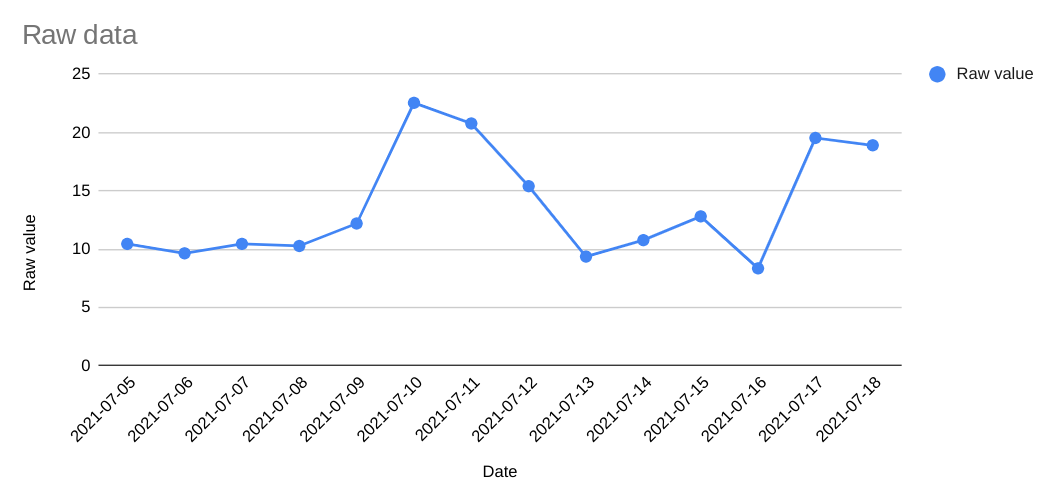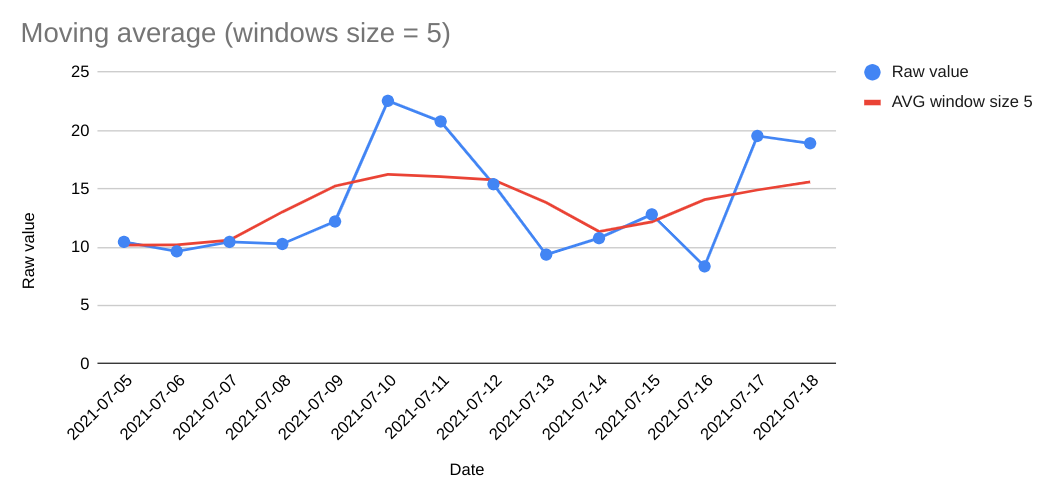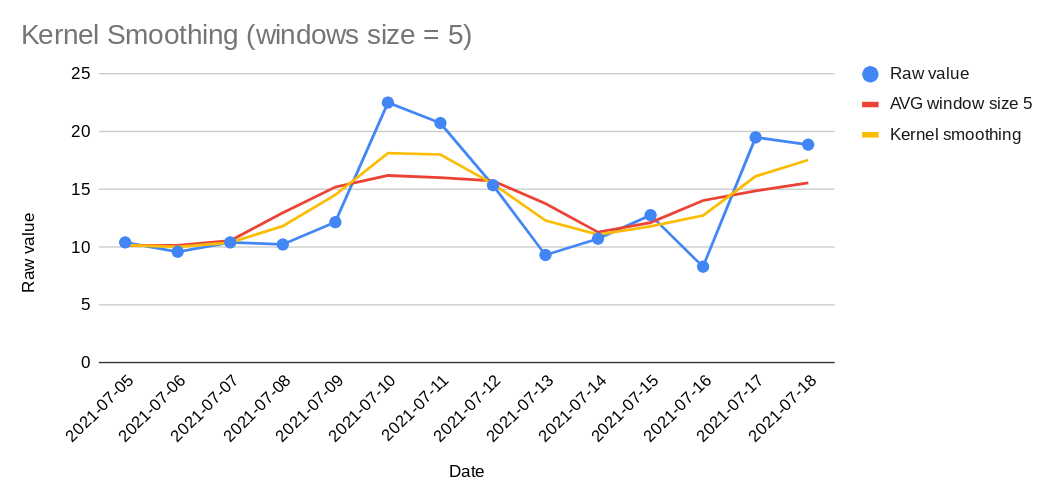Circular kernel smoothing in SQL
Smoothing things over (simple case)
Lets generate some data - we look at a noisy (and jittery) signal over a few days:
CREATE OR REPLACE TABLE measurements AS
SELECT *
FROM (VALUES
(1001, CAST('2021-07-05' AS DATE), 10.45),
(1001, CAST('2021-07-06' AS DATE), 9.64),
(1001, CAST('2021-07-07' AS DATE), 10.45),
(1001, CAST('2021-07-08' AS DATE), 10.27),
(1001, CAST('2021-07-09' AS DATE), 12.2),
(1001, CAST('2021-07-10' AS DATE), 22.55),
(1001, CAST('2021-07-11' AS DATE), 20.78),
(1001, CAST('2021-07-12' AS DATE), 15.4),
(1001, CAST('2021-07-13' AS DATE), 9.36),
(1001, CAST('2021-07-14' AS DATE), 10.77),
(1001, CAST('2021-07-15' AS DATE), 12.81),
(1001, CAST('2021-07-16' AS DATE), 8.35),
(1001, CAST('2021-07-17' AS DATE), 19.54),
(1001, CAST('2021-07-18' AS DATE), 18.91)
) AS t(user_id, date, measurement)
SELECT date, measurement FROM measurements
| date | meansurement |
|---|---|
| 2021-07-05 | 10.45 |
| 2021-07-06 | 9.64 |
| 2021-07-07 | 10.45 |
| 2021-07-08 | 10.27 |
| 2021-07-09 | 12.2 |
| 2021-07-10 | 22.55 |
| 2021-07-11 | 20.78 |
| 2021-07-12 | 15.4 |
| 2021-07-13 | 9.36 |
| 2021-07-14 | 10.77 |
| 2021-07-15 | 12.81 |
| 2021-07-16 | 8.35 |
| 2021-07-17 | 19.54 |
| 2021-07-18 | 18.91 |

The moving average
One of the simplest ways of “smoothing” a series of values is the moving average. If we have full data and evenly spaced values (in this example - daily data), this is in fact one of the simplest kernel smoother so it’s a good place to start (see “kernel average smoother”). An implementation of a moving average exists in pracically all SQL dialects as a one-liner, using window functions. For example a 5 day moving window can be implemented as:
SELECT
m.date
,m.measurement
,AVG(m.measurement)
OVER (PARTITION BY m.user_id ORDER BY m.date ROWS BETWEEN 2 PRECEDING AND 2 FOLLOWING) AS moving_avg_5_days
| date | meansurement | moving_avg_5_days |
|---|---|---|
| 2021-07-05 | 10.45 | 10.18 |
| 2021-07-06 | 9.64 | 10.2025 |
| 2021-07-07 | 10.45 | 10.602 |
| 2021-07-08 | 10.27 | 13.022 |
| 2021-07-09 | 12.2 | 15.25 |
| 2021-07-10 | 22.55 | 16.24 |
| 2021-07-11 | 20.78 | 16.058 |
| 2021-07-12 | 15.4 | 15.772 |
| 2021-07-13 | 9.36 | 13.824 |
| 2021-07-14 | 10.77 | 11.338 |
| 2021-07-15 | 12.81 | 12.166 |
| 2021-07-16 | 8.35 | 14.076 |
| 2021-07-17 | 19.54 | 14.9025 |
| 2021-07-18 | 18.91 | 15.6 |

Kernel weights (not all days are the same)
What is kernel smoothing? Well you’ve just seen it in action. A moving average is a form of kernel smoothing where all observations inside the window are weighted the same way. We can introduce more complex ideas of smoothing by changing the weights we assign for each position inide the window. For example: What if we wanted to give “closer” days higher weights?
window range
<----------------------------->
| 10% | 20% | 40% | 20% | 10% |
...----------|-----|-----|-----|-----|-----|-----|--...
relative date -2 -1 0 1 2 3 4
The most generic (and safe) way to specify weights is to use an explicit CASE WHEN statement. This allows for any kind of window and also for non-symmetrics weights:
CASE
WHEN reference_date - window_date = 2 THEN 1
WHEN reference_date - window_date = 1 THEN 2
WHEN reference_date - window_date = 0 THEN 4
WHEN reference_date - window_date = -1 THEN 2
WHEN reference_date - window_date = -2 THEN 1
ELSE 0
END
Where reference_date is the date we want to calculate and window_date are the values inside the window. Note that we don’t have to normalize weights to SUM(weights) = 1 since we handle that in the query. And anyway - we have to handle the edges manually when not using the window functions (for example, the next to last place will only have 4 observations in the window and we need account for that)
SELECT
m.user_id
,m.date
,MIN(m.measurement) AS measurement
,1.0 * SUM(m.measurement) / COUNT(1) AS moving_avg
,1.0 * SUM(
CASE
WHEN m.date - m2.date = 2 THEN 1
WHEN m.date - m2.date = 1 THEN 2
WHEN m.date - m2.date = 0 THEN 4
WHEN m.date - m2.date = -1 THEN 2
WHEN m.date - m2.date = -2 THEN 1
ELSE 0
END * m2.measurement
) / SUM( -- we don't divide by a constant here so we can handle the edges correctly
CASE
WHEN m.date - m2.date = 2 THEN 1
WHEN m.date - m2.date = 1 THEN 2
WHEN m.date - m2.date = 0 THEN 4
WHEN m.date - m2.date = -1 THEN 2
WHEN m.date - m2.date = -2 THEN 1
ELSE 0
END
) AS moving_weighted_avg
FROM measurements m
LEFT JOIN measurements m2
ON m2.user_id = m.user_id
AND m2.date >= m.date - INTERVAL '2' DAY
AND m2.date <= m.date + INTERVAL '2' DAY
GROUP BY 1,2
And get
| user_id | date | measurement | moving_avg | moving_weighted_average |
|---|---|---|---|---|
| 1001 | 2021-07-05 | 10.45 | 10.18 | 10.219 |
| 1001 | 2021-07-06 | 9.64 | 10.2025 | 10.07 |
| 1001 | 2021-07-07 | 10.45 | 10.602 | 10.427 |
| 1001 | 2021-07-08 | 10.27 | 13.022 | 11.857 |
| 1001 | 2021-07-09 | 12.2 | 15.25 | 14.567 |
| 1001 | 2021-07-10 | 22.55 | 16.24 | 18.183 |
| 1001 | 2021-07-11 | 20.78 | 16.058 | 18.058 |
| 1001 | 2021-07-12 | 15.4 | 15.772 | 15.52 |
| 1001 | 2021-07-13 | 9.36 | 13.824 | 12.337 |
| 1001 | 2021-07-14 | 10.77 | 11.338 | 11.117 |
| 1001 | 2021-07-15 | 12.81 | 12.166 | 11.838 |
| 1001 | 2021-07-16 | 8.35 | 14.076 | 12.778 |
| 1001 | 2021-07-17 | 19.54 | 14.9025 | 16.166 |
| 1001 | 2021-07-18 | 18.91 | 15.6 | 17.581 |

Missing values and un-evenly spaced observations
So far we made two assumptions that made specifying the kernel function easy:
- Our observations don’t contain missing values
- Our observations are evenly spaced
What if we have data that does not meet these requirements?
Handling missing values
Our code already accounts for missing values in some way - since we had to handle the the edges of the line, where we don’t have either the left of the right side of the window.
One addition we should make here is to make sure we have “enough” values to calculate a meaningful window: In many cases our reason for smoothing is that we want to avoid outliers. If the point we are tring to smooth has no data around it, we might not want to allow it to totally “dominate” the smoothed prediction.
One simple way to achive this is to require a minimal number of points to fall inside the window in order to make a smoothed predcition. In our code all we have to do is add a HAVING clause:
SELECT
...
GROUP BY 1,2
HAVING COUNT(1) >= 3
(note that here I used >= 3 as a threshold to make sure that we don’t drop the edges, but we can use smarter conditions to account for points near the edges of the line… TBD)
Arbitrarily spaced values
Our first example used daily data, so we have evenly-spaced observations and a simple way to define windows and kernels - in fact we could define the kernel function as a CASE WHEN conditions. However in many cases we will have observations arbitrarily spaced on the X-axis, which means we don’t know in advance what will be the distance between our reference point and other data points inside the window.
In principle, this case is very similar to having missing values - just consider some minimal unit as the base unit (one hour / minute / second, or some minimal distance on the X-axis) and you can see how this translates to very “dense” evenly-spaced values with lots of missing values. This works well for the definition of the range of the kernel, but might not work well for the definition of the weights (the CASE WHEN statement can become very long…)
Some possible solutions:
-
Replace the
CASE WHENstatement with a continuous function. In the example above we can usePOWER(2, 2 - abs(reference_point - point_in_window)) -
Keep original
CASE WHENstatement but use ranges instead. You have to be mindful of how you define borderline between the ranges. Foe example here we use theX.5mark so all ranges close to the reference observation get a value of4
CASE
WHEN reference_date - window_date < -2.5 THEN 0
WHEN reference_date - window_date < -1.5 THEN 1
WHEN reference_date - window_date < -0.5 THEN 2
WHEN reference_date - window_date < 0.5 THEN 4
WHEN reference_date - window_date < 1.5 THEN 2
WHEN reference_date - window_date < 2.5 THEN 1
ELSE 0
END
You can of course be “safer” and specify WHEN reference_date - window_date < -1.5 AND reference_date - window_date >= -2.5 THEN 1 but let’s save some ink…)
Making it circular
TBD: Add day-of-week
SELECT
user_id
,date
,date_format(date, 'E') AS day_of_week
,measurement